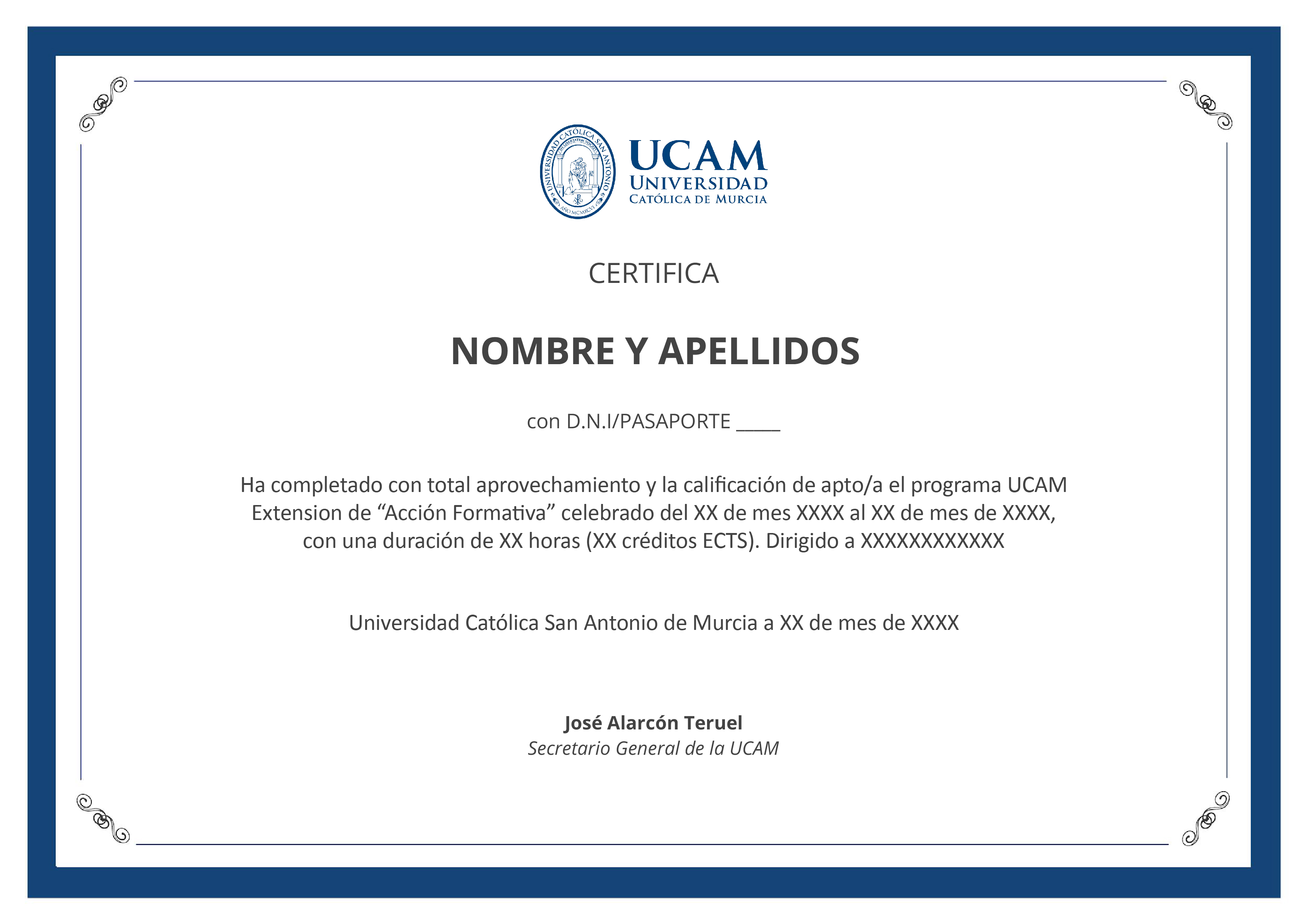Modalidad
Online
Duración - Créditos
1500 horas - 60 ECTS
Plataforma Web
24 Horas
Centro Líder
formación online
Profesionales
Docentes especializados
Acompañamiento
Personalizado
Reconocidos por:

Acreditados como:
Temario
MODULE 1. DISASTER RISK MANAGEMENT AND CLIMATE CHANGE. CONCEPTS AND CONTEXT
MODULE 2. PROSPECTIVE AND CORRECTIVE RISK MANAGEMENT
MODULE 3. CLIMATE VARIABILITY AND CLIMATE CHANGE
MODULE 4. ICT AND GIS APPLIED IN THE MANAGEMENT OF DISASTER RISK AND CLIMATE CHANGE
MODULE 5. DISASTER RISK FINANCIAL MANAGEMENT AND CLIMATE FINANCE
MODULE 6. DISASTER MANAGEMENT AND RECOVERY
MODULE 7. ENVIRONMENTAL AND DISASTER RISK MANAGEMENT TOOLS AT TERRITORIAL SCALES
MODULE 8. PUBLIC, PRIVATE AND COMMUNITY INVESTMENT TOOLS
MODULE 9. DISASTER RISK CORRECTIVE MANAGEMENT
MODULE 10. MFP. MASTER´S DEGREE IN DISASTER RISK MANAGEMENT AND RESILIENCE STRATEGIES AND TOOLS
Opiniones
Lo que dicen nuestros alumnos:
Grace Norris
Lichfield
In this training, I have achieved a new job position. They were looking for a professional capable of managing these situations, and my experience, knowledge, and the degree supporting them have helped me obtain it.
Aliyah Collins
Chicago
Thanks to having the master s degree in online mode, I was able to combine it with my work without any problem. I am very happy to have studied with you.
Susan Brown
Bristol
The content is highly specialized, the difficulty is not very high, but it allows you to be prepared for any type of weather setback.
John Mitchell
London
The title was what caught my attention the most, along with the price. The syllabus was extensive, and the explanations were detailed. Very satisfied with Euroinnova.
Virginia Roberts
Birmingham
Very happy with this training, I never imagined I would learn so much about disaster management from home; as a firefighter, it will be of great help to me.
Plan de estudios








Titulación de master in risk management



Claustro docente






Master in Risk Management
The Master in Risk Management aims to carry out professional activities to identify, assess, and manage risks in the face of disasters that may occur, especially those related to climate. Now, you can perform this activity optimally and efficiently with the tools and knowledge made available to you.
Euroinnova International Online Education offers you the opportunity to enroll in the Master in Risk Management at the best price, encouraging research and generating proposals regarding risk management with resilience. Understand how it is managed and the climatological reasons why such events can happen.

What is Disaster Risk Management?
The master's program aims to manage the different disasters that any project or field may face. Post-disaster financing and other activities will be covered throughout this training, enabling efficient management and addressing the necessary needs.
Moreover, there are many tools and instruments that can be used to help restore the initial situation, effectively dealing with damages caused by these phenomena. Climate change poses a significant risk to all sectors of society, including social, economic, and environmental aspects. For this reason, sustainable development goals were established to efficiently manage the risk and reduce the impact of climatic phenomena that could lead to disasters.
Some of the main disasters that can affect society and organizations due to changing weather conditions are as follows:
-
Diseases: New and more complex diseases that affect society are emerging. Malaria, transmitted by mosquitoes, is estimated to increase by approximately 500 million people within the next 25 years.
-
Droughts: Drought is a major problem in our country, and many areas around the world are at risk of extreme drought. Knowing how to manage this situation is crucial.
-
Cyclones: Storms have a significant impact on society, especially when they become devastating. It is predicted that they may occur more frequently if the current situation continues.
-
Flooding: Flooding is becoming more common in areas where it never occurred before, and these occurrences may increase in the coming years.
-
Heatwaves: Heatwaves are already present and could worsen over the years.
Having specific knowledge to manage the risk of these natural disasters and facing them with available tools and instruments is essential, and this can be achieved through this training.
Strategy for Disaster Risk Management
With this training, you will learn how to carry out proper disaster risk management, reducing the risk and being prepared for such situations. The following elements will be part of the risk management strategy:
-
Strengthening Objectives: Strengthening resilience economically, environmentally, or in health is crucial for reducing risks.
-
Understanding Risk: Evaluating, understanding, and knowing the damages resulting from disasters can help improve the situation.
-
Goals: Setting goals over different timeframes will provide indicators to detect threats.
-
Prevention Objectives: Incorporating prevention objectives into the strategy design.
-
Investment: Investing in risk reduction, as seen in the Sustainable Development Goals, will decrease the risk and enhance resilience.
Roles of Civil Protection
Among the main activities carried out by Civil Protection in Spain, we highlight:
- Continuous planning of activities to avoid, to a certain extent, the risk, and evaluate it.
- Attempting to prevent certain actions by promoting prior surveillance to guarantee risk reduction.
- Intervention during disasters, aiming to protect and support the population.
- Informing the public about existing risks and preventive measures.
- Rehabilitation of tasks and management that lead to the restoration of essential services.
These profiles should exhibit certain characteristics such as commitment, prevention, responsibility, order, humility, simplicity, fairness, and professionalism.
Types of Emergencies
It is necessary to differentiate between different types of emergencies and know who intervenes in each one. This classification is generally based on the place where the emergency occurs:
-
Conato of Emergencies: This refers to a simple accident or risk that, after evaluation, is considered manageable by the center itself. In some cases, external assistance may be required.
-
Parcial Emergencies: This involves accidents where specialized teams' assistance is needed. The affected area must be controlled and managed.
-
General Emergencies: In this type of emergency, almost all emergency services are required. They will manage the evacuation of personnel and isolate the affected area.
Would you like to deepen your knowledge in this field? Enroll in the Master's in Disaster Management offered by Euroinnova and take advantage of the opportunity to delve into the emergency sector.

Get expert training in the field of disaster risk management right now with this master's program offered by Euroinnova International Online Education.
Now you can obtain a University Degree issued by the Catholic University of Murcia with 60 ECTS in collaboration with Structuralia.
Request information without any obligation about the Master in Risk Management.
For more related courses click here
We are waiting for you!

¡Muchas gracias!
Hemos recibido correctamente tus datos. En breve nos pondremos en contacto contigo.

